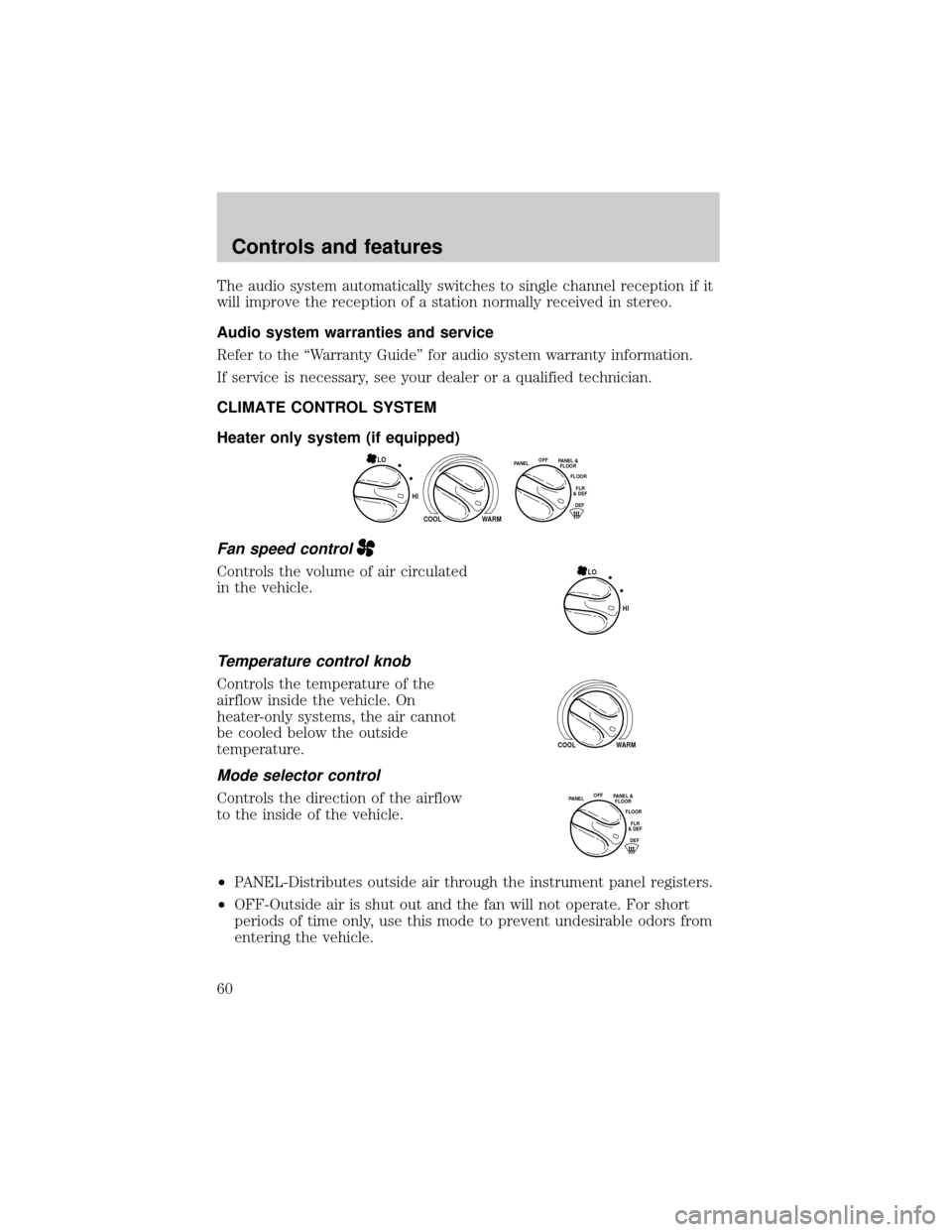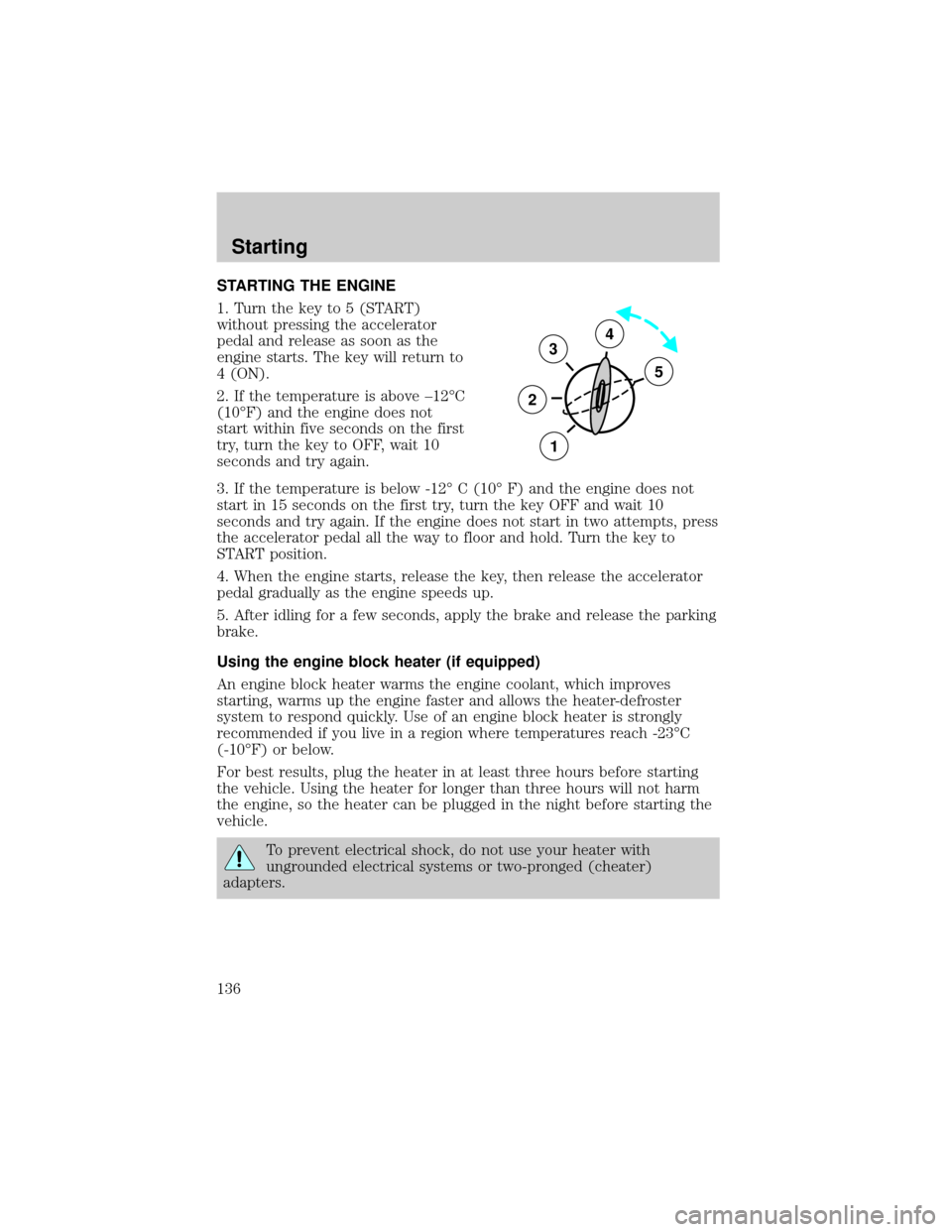2000 FORD F150 heater
[x] Cancel search: heaterPage 60 of 280

The audio system automatically switches to single channel reception if it
will improve the reception of a station normally received in stereo.
Audio system warranties and service
Refer to the ªWarranty Guideº for audio system warranty information.
If service is necessary, see your dealer or a qualified technician.
CLIMATE CONTROL SYSTEM
Heater only system (if equipped)
Fan speed control
Controls the volume of air circulated
in the vehicle.
Temperature control knob
Controls the temperature of the
airflow inside the vehicle. On
heater-only systems, the air cannot
be cooled below the outside
temperature.
Mode selector control
Controls the direction of the airflow
to the inside of the vehicle.
²PANEL-Distributes outside air through the instrument panel registers.
²OFF-Outside air is shut out and the fan will not operate. For short
periods of time only, use this mode to prevent undesirable odors from
entering the vehicle.
HI
COOL WARM
OFFPANELFLOOR
DEFFLR
& DEF PANEL &
FLOOR
LO
HI LO
COOL WARM
OFFPANELFLOOR
DEFFLR
& DEF PANEL &
FLOOR
Controls and features
60
Page 136 of 280

STARTING THE ENGINE
1. Turn the key to 5 (START)
without pressing the accelerator
pedal and release as soon as the
engine starts. The key will return to
4 (ON).
2. If the temperature is above ±12ÉC
(10ÉF) and the engine does not
start within five seconds on the first
try, turn the key to OFF, wait 10
seconds and try again.
3. If the temperature is below -12É C (10É F) and the engine does not
start in 15 seconds on the first try, turn the key OFF and wait 10
seconds and try again. If the engine does not start in two attempts, press
the accelerator pedal all the way to floor and hold. Turn the key to
START position.
4. When the engine starts, release the key, then release the accelerator
pedal gradually as the engine speeds up.
5. After idling for a few seconds, apply the brake and release the parking
brake.
Using the engine block heater (if equipped)
An engine block heater warms the engine coolant, which improves
starting, warms up the engine faster and allows the heater-defroster
system to respond quickly. Use of an engine block heater is strongly
recommended if you live in a region where temperatures reach -23ÉC
(-10ÉF) or below.
For best results, plug the heater in at least three hours before starting
the vehicle. Using the heater for longer than three hours will not harm
the engine, so the heater can be plugged in the night before starting the
vehicle.
To prevent electrical shock, do not use your heater with
ungrounded electrical systems or two-pronged (cheater)
adapters.
3
2
1
5
4
Starting
136
Page 191 of 280

Do not attempt to push start your vehicle. Automatic
transmissions do not have push-start capability.
Preparing your vehicle
When the battery is disconnected or a new battery is installed, the
transmission must relearn its adaptive strategy. As a result of this, the
transmission may shift firmly. This operation is considered normal and
will not effect function or durability of the transmission. Over time, the
adaptive learning process will fully update transmission operation to its
optimum shift feel.
1.Use only a 12±volt supply to start your vehicle.
2. Do not disconnect the battery of the disabled vehicle as this could
damage the vehicle's electrical system.
3.
Park the booster vehicle close to the hood of the disabled vehicle
making sure the two vehiclesdo nottouch. Set the parking brake on both
vehicles and stay clear of the engine cooling fan and other moving parts.
4. Check all battery terminals and remove any excessive corrosion before
you attach the battery cables. Ensure that vent caps are tight and level.
5. Turn the heater fan on in both vehicles to protect any electrical
surges. Turn all other accessories off.
Connecting the jumper cables
1. Connect the positive (+) booster cable to the positive (+) terminal of
the discharged battery.
Note:In the illustrations,lightning boltsare used to designate the
assisting (boosting) battery.
+–+–
Roadside emergencies
191
Page 268 of 280

Comfort and convenience
Air conditioner
Air filtration systems
Automatic Headlamp System with Daytime Running Lights (DRL)
Cargo nets
Cargo organizers (interior)
Cargo storage bin (regular cab)
Cargo trays (interior)
Celluar phone holder
Dash trim (wood grain)
Engine block heaters
Manual sliding rear window
Moon roof deflector
Power sliding rear window
Rapid heat system
Tire step
Travel equipment
Bed mount bike carrier
Bumper mount bike carrier
Daytime running lights (DRL)
Fog lights
Heavy-duty battery
Hitch mount bike carrier
Inside mirror with compass display
Inside mirror with compass and temperature display
Outside signal mirror (available only with power mirrors)
Pickup box rails
Retractable bed hooks
Running boards (molded, diamond plate, tubular and stirrup step)
Seatback organizer
Customer assistance
268
Page 275 of 280

check engine/
service engine soon light .........11
cleaning ...................................243
coolant .....................................206
fail-safe coolant ......................211
idle speed control ...................218
lubrication
specifications ..................251, 253
refill capacities ........................248
service points ..................199±200
starting after a collision .........176
Engine block heater .................136
Engine oil ..................................200
checking and adding ..............200
dipstick ....................................200
filter, specifications ........203, 247
recommendations ...................203
refill capacities ........................248
specifications ..................251, 253
Exhaust fumes ..........................137
F
Fail safe cooling ........................211
Floor mats ...................................81
Fluid capacities .........................248
Foglamps .....................................21
Four-Wheel
Drive vehicles ......................14, 153
control trac ...............................23
description ..............................156
driving off road .......................157
electronic shift ..................23, 156
indicator light ...................14, 154
lever operated shift ................154
preparing to drive your
vehicle .....................................143
Fuel ............................................227
calculating fuel economy .......231cap ...........................................230
capacity ...................................248
choosing the right fuel ...........229
comparisons with EPA
fuel economy estimates .........234
detergent in fuel .....................230
filling your vehicle
with fuel ..................227, 230, 232
filter, specifications ........231, 247
fuel pump shut-off switch .....176
gauge .........................................16
improving fuel economy ........231
low fuel warning light ..............10
octane rating ...................229, 253
quality ......................................229
running out of fuel .................230
safety information relating to
automotive fuels .....................227
Fuses ..................................177, 179
G
Garage door opener ....................74
Gas cap (see Fuel cap) ............230
Gas mileage
(see Fuel economy) .................231
Gauges .........................................16
battery voltage gauge ...............18
engine coolant
temperature gauge ...................17
engine oil pressure gauge ........19
fuel gauge ..................................16
odometer ...................................17
speedometer .............................17
tachometer ................................18
trip odometer ............................18
GAWR
(Gross Axle Weight Rating) .....160
calculating ...............................162
definition .................................160
Index
275
Page 276 of 280

driving with a heavy load ......160
location ....................................160
GVWR (Gross
Vehicle Weight Rating) .............160
calculating .......................160, 162
definition .................................160
driving with a heavy load ......160
location ....................................160
H
Hazard flashers .........................176
Headlamps ...................................20
aiming ......................................242
autolamp system .......................22
bulb specifications ..................241
daytime running lights .............20
flash to pass ..............................20
high beam ...........................13, 20
replacing bulbs .......................237
turning on and off ....................20
warning chime ..........................15
Heating ........................................60
heater only system ...................60
heating and
air conditioning system ............62
Hood ..........................................198
I
Ignition .................................66, 253
removing the key ....................153
Infant seats
(see Safety seats) .....................123
Inspection/maintenance
(I/M) testing ..............................236
Instrument panel
cleaning ...................................245
cluster ................................10, 245lighting up
panel and interior .....................21
location of components ............10
J
Jack ............................................185
positioning ...............................185
storage .....................................185
Jump-starting your vehicle ......190
K
Keyless entry system
autolock .....................................91
locking and unlocking doors ....95
programming entry code .........95
Keys
key in ignition chime ...............15
positions of the ignition ...........66
removing from the ignition ....153
L
Lamps
autolamp system .......................22
bulb replacement
specifications chart ................241
cargo lamps ...............................21
daytime running light ...............20
fog lamps ...................................21
headlamps .................................20
headlamps, flash to pass ..........20
instrument panel, dimming .....21
interior lamps ...........................77
replacing bulbs ...............236±241
Lane change indicator
(see Turn signal) ........................66
Lights, warning and indicator ....10
air bag ........................................12
Index
276